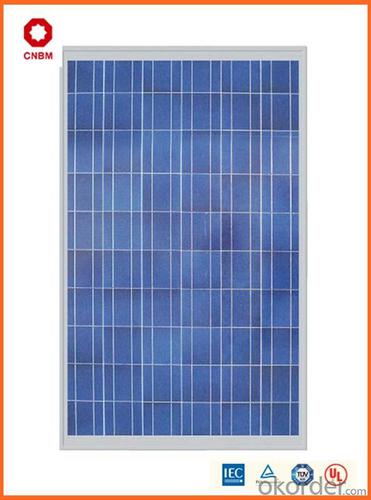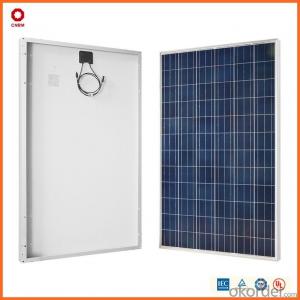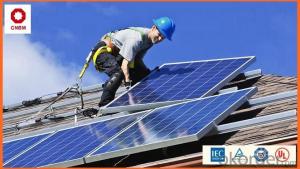30w Small Solar Panels in Stock - Solar Energy Systems Windermere - China Manufacturer
- Loading Port:
- China main port
- Payment Terms:
- TT OR LC
- Min Order Qty:
- 10 watt
- Supply Capability:
- 10000000 watt/month
OKorder Service Pledge
OKorder Financial Service
You Might Also Like
Specification
Product Description:
Hot Sale !!! Quality and Safety of Small Poly Solar Panel 5w~150w
1. Rigorous quality control meets the highest international standards.
2. High-transmissivity low-iron tempered glass, strong aluminium frame.
3. Using UV-resistant silicon.
4. IS09001/14001/CE/TUV/UL
Warranties of Small Poly Solar Panel 35~85w
1. 10 years limited product warranty
2. 15 years at 90% of the minimal rated power output
3. 25 years at 80% of the minimal rated power output
Specification
Characteristics of Poly solar panels CNBM (245-320W) | |||||
Max Power Voltage Vmp(V) | 30.3 | 30.8 | 31.1 | 31.4 | 31.85 |
Max Power Current Imp(A) | 7.60 | 7.64 | 7.73 | 7.81 | 7.85 |
Open Circuit Voltage Voc(V) | 36.1 | 36.6 | 37 | 37.3 | 37.68 |
Short Circuit Current Isc(A) | 8.50 | 8.55 | 8.65 | 8.75 | 8.85 |
Max Power Pm(W) | 230W | 235W | 240W | 245W | 250W |
Temperature Coefficient of Cells Poly solar panels CNBM (245-320W) | |
NOCT | 45± 2 |
Temperature Coeffucients of Isc | 0.0492 |
Temperature Coeffucients of Voc | -0.3374 |
Temperature Coeffucients of Voc | -0.4677 |
Mechanical Data of Poly solar panels CNBM (245-320W) | |
Dimension | 1638 × 982 × 40 mm |
Weight | 19.5 kg |
No. of Cells and Connections | 60 (6 ×10) |
Tolerance | 0 ~ + 5 W |
Cell | Monocrystalline Cell 156 × 156 mm |
Packing | 624 Pcs/40ft(H) Container |
Limits of Poly solar panels CNBM (245-320W) | |
Operating Temperature | -40 to +85 |
Storage Temperature | -40 to +85 |
Max System Voltage | 1000VDC(IEC) / 600VDC(UL) |
Features of our products:
• High conversion efficiency mono/poly-crystalline amorphous silicon solar cells
• Modules incorporate high performance bypass diodes to minimize the power drop caused by shading
• High transmittance, low-iron tempered glass
• High performance EVA encapsulant to prevent destroying and water.
• AI frame: without screw, corner connection. 8 holes on the frame can be installed easily
• Good performance of preventing from atrocious weather such as wind and hails
• Certifications: CE IEC TUV VDE UL, Class I
• 10 years 90% power output warranty

Shipping of Small Poly Solar Panel 35~85w
By Sea | Delivery from Shanghai or Ningbo seaport |
By Air | Departure from Shanghai Pudong Airport |
By Express | Post by DHL, EMS, UPS, TNT. |
Features of our products:
• High conversion efficiency mono/poly-crystalline amorphous silicon solar cells
• Modules incorporate high performance bypass diodes to minimize the power drop caused by shading
• High transmittance, low-iron tempered glass
• High performance EVA encapsulant to prevent destroying and water.
• AI frame: without screw, corner connection. 8 holes on the frame can be installed easily
• Good performance of preventing from atrocious weather such as wind and hails
• Certifications: CE IEC TUV VDE UL, Class I
• 10 years 90% power output warranty
As a professional Solar Panel manufacturer and Supplier in China, we have our customers come around the whole world and our specialization has got a worldwide recognition. Meanwhile, with our superior quality, competitive price, prompt and excellent service, As main role in trade section of CNBM Group, CNBM International Corporation supplies products including Monocrystalline Solar Panel, Polycrystalline Solar Panel ( multicrystalline silicon Solar Panel) have received and enjoyed famous reputation in many countries and regions in the world.
- Q: Can solar energy systems be used in disaster relief efforts?
- Indeed, solar energy systems have proven to be effective in disaster relief endeavors, gaining popularity and significance in such situations. When calamities strike, they frequently disrupt the electricity supply, leaving affected areas devoid of power for extended periods, ranging from days to even weeks. This absence of electricity hinders relief efforts, impeding the provision of basic necessities such as lighting, medical care, communication, and clean water. In contrast, solar energy systems offer a dependable and sustainable power source in these circumstances. Consisting of solar panels that convert sunlight into electricity, these systems can energize various devices and appliances. They can be rapidly deployed to disaster-stricken regions, providing immediate access to electricity without relying on conventional power grids. There are numerous advantages to employing solar energy systems in disaster relief operations. Firstly, solar power is renewable and abundant, ensuring a continuous electricity supply even during prolonged emergencies. Secondly, these systems typically require minimal maintenance, decreasing the need for constant fuel supply or repairs. Consequently, they are more cost-effective and reliable in disaster-prone areas. Solar energy systems can be utilized in various ways during disaster relief endeavors. For instance, they can power mobile charging stations, enabling individuals to charge their phones and stay connected with their loved ones. Solar-powered lighting can illuminate temporary shelters, hospitals, and walkways, enhancing safety and security for victims and aid workers alike. Additionally, solar energy can power water purification systems, guaranteeing access to clean drinking water in regions where water infrastructure has been damaged or contaminated. Moreover, solar energy systems can be seamlessly integrated into existing relief infrastructure. Hospitals, schools, and community centers can have solar panels installed on their roofs, ensuring a reliable electricity source for critical operations. This reduces reliance on diesel generators or other fossil fuel-powered alternatives, which tend to be costly, noisy, and emit harmful pollutants. In conclusion, solar energy systems are immensely advantageous in disaster relief efforts. They offer a sustainable and dependable power source, facilitating essential services and enhancing overall relief operations. As the world grapples with increasingly frequent and severe natural disasters, the utilization of solar energy systems in disaster relief will continue to gain significance.
- Q: Are there any risks of electrical shocks during installation or maintenance of solar energy systems?
- During the installation or maintenance of solar energy systems, one must be aware of the risks of electrical shocks. These systems involve working with electrical components, such as solar panels, inverters, and batteries, which carry high voltage. Failure to follow proper safety measures can result in contact with live electrical parts and the possibility of receiving an electrical shock. Several factors can contribute to the risk of electrical shocks, including improper installation, insufficient knowledge or training in electrical systems, failure to use personal protective equipment (PPE), and inadequate grounding. It is crucial to adhere to safety guidelines and regulations when installing or maintaining solar energy systems. This includes wearing insulated gloves, using insulated tools, and ensuring proper grounding. Furthermore, working at heights during installation or maintenance introduces an additional hazard of electrical shocks. Care must be taken to prevent falls or accidental contact with live electrical parts while working on rooftops or elevated areas. To minimize the risks of electrical shocks, it is advisable to hire qualified and trained professionals for the installation and maintenance of solar energy systems. Regular inspections and maintenance checks should also be conducted to identify and address any potential electrical hazards. In conclusion, while solar energy systems offer many benefits, it is vital to be aware of the potential risks of electrical shocks and take the necessary precautions to ensure the safety of individuals involved in the installation or maintenance process.
- Q: Can solar energy systems be used in educational settings for teaching purposes?
- Yes, solar energy systems can definitely be used in educational settings for teaching purposes. They provide a practical and hands-on way to teach students about renewable energy sources, environmental sustainability, and the benefits of solar power. By using solar energy systems, students can learn about the science behind solar energy, understand how it is harnessed, and even participate in the installation and maintenance processes. This interactive approach not only enhances their understanding of solar power but also promotes critical thinking and problem-solving skills. Additionally, solar energy systems in educational settings serve as a great demonstration of sustainable practices, inspiring students to adopt eco-friendly behaviors and contribute towards a greener future.
- Q: Can solar energy systems be used in areas with frequent hurricanes?
- Yes, solar energy systems can be used in areas with frequent hurricanes. While it is true that hurricanes can cause damage to solar panels and other components of solar energy systems, there are measures that can be taken to mitigate these risks. Firstly, the design and installation of solar energy systems in hurricane-prone areas can be done to withstand high winds. This includes using stronger mounting systems, reinforced frames, and secure anchoring techniques. Additionally, the orientation and tilt angle of the panels can be optimized to minimize wind resistance. Furthermore, regular maintenance and inspections can help identify any potential issues or damage to the system before a hurricane hits. This allows for timely repairs or replacements, ensuring the system remains functional and safe during extreme weather events. In the event of a hurricane, it is important to have emergency procedures in place to secure the solar panels and other components. This can involve temporarily removing the panels and securing them indoors or utilizing protective covers to shield them from debris. Moreover, the use of microinverters or power optimizers in solar energy systems can enhance their resilience in hurricane-prone areas. These technologies allow each solar panel to operate independently, mitigating the impact of any damage to a single panel and preventing the entire system from shutting down. Lastly, solar energy systems can also contribute to the resilience of communities during and after hurricanes. With proper battery storage, solar systems can provide backup power during power outages, allowing essential services to continue operating and providing electricity for critical needs such as lighting, refrigeration, and medical equipment. Overall, while precautions need to be taken to ensure the durability and functionality of solar energy systems in hurricane-prone areas, they can be effectively used to harness clean and renewable energy even in the face of frequent hurricanes.
- Q: Are solar energy systems noisy?
- No, solar energy systems are not noisy. They do not produce any sound while generating electricity from sunlight.
- Q: What is the role of solar energy systems in reducing dependence on fossil fuels?
- Solar energy systems play a crucial role in reducing dependence on fossil fuels by providing a clean and renewable source of energy. Fossil fuels, such as coal, oil, and natural gas, have been the primary sources of energy for centuries. However, their extraction, transportation, and combustion have significant environmental impacts, including air pollution, greenhouse gas emissions, and climate change. Solar energy systems, on the other hand, utilize the power of the sun to generate electricity. Solar panels, made up of photovoltaic cells, convert sunlight into usable energy without emitting any harmful pollutants. This clean energy source not only helps to mitigate climate change but also improves air quality and reduces health risks associated with fossil fuel combustion. By embracing solar energy systems, we can reduce our dependence on fossil fuels for electricity generation, heating, and cooling. Solar power is abundant, widely distributed, and available throughout the year, making it a reliable and sustainable energy option. Moreover, solar energy systems can be installed on various scales, from residential rooftops to large-scale solar farms, allowing individuals, communities, and businesses to contribute to the transition away from fossil fuels. Not only does solar energy reduce our carbon footprint, but it also provides economic benefits. As the technology advances and becomes more widespread, the cost of solar panels and installation continues to decline. This makes solar energy more affordable and accessible for both individuals and businesses, leading to job creation and economic growth in the renewable energy sector. Furthermore, solar energy systems offer energy independence and resilience. Unlike fossil fuels, which are finite resources and subject to price volatility, sunlight is abundant and freely available. By harnessing solar power, we can reduce our reliance on imported fossil fuels, enhance energy security, and create a more stable and sustainable energy supply. In conclusion, solar energy systems play a crucial role in reducing dependence on fossil fuels. By harnessing the power of the sun, we can transition to a cleaner, more sustainable, and resilient energy future. Solar energy helps mitigate climate change, improve air quality, create jobs, and provide energy independence. It is a viable solution that enables us to reduce our environmental footprint while meeting our energy needs.
- Q: How do solar energy systems impact wildlife habitats?
- Solar energy systems can have both positive and negative impacts on wildlife habitats. On the positive side, these systems do not emit greenhouse gases, reducing air pollution and mitigating climate change, which can benefit wildlife in the long run. Moreover, solar panels can be installed on rooftops or in non-intrusive areas, minimizing disturbance to wildlife habitats. However, large-scale solar projects can disrupt ecosystems by clearing land or displacing wildlife. Therefore, careful planning and implementation of solar energy systems are crucial to minimize negative impacts on wildlife habitats.
- Q: Can solar energy systems be used in areas with high levels of hail or other severe weather conditions?
- Yes, solar energy systems can be used in areas with high levels of hail or other severe weather conditions. However, it is important to select appropriate materials and design the system to withstand these conditions. For instance, using hail-resistant panels, positioning them at an angle, and employing protective measures can help mitigate the potential damage caused by hail or severe weather. Proper maintenance and insurance coverage are also advisable to ensure the longevity and efficiency of the solar energy system in such areas.
- Q: Can solar energy systems be used for powering outdoor surveillance cameras?
- Certainly, outdoor surveillance cameras can be powered by solar energy systems. These systems are composed of solar panels that convert sunlight into electrical energy. This electricity can be utilized to operate various devices, including outdoor surveillance cameras. Sunlight captured by the solar panels, when installed near the cameras, is transformed into electrical energy that can be either stored in batteries or used directly to power the cameras. Consequently, there is no need for traditional power sources or the installation of electrical wires in remote locations. This solution is not only cost-effective but also environmentally friendly. Moreover, solar energy systems ensure a dependable and uninterrupted power supply, even in areas with limited access to electricity, thus guaranteeing continuous surveillance capabilities.
- Q: I usually have to use about 10 degrees, more in the summer! Winter sunshine time 10 hours! Who knows how much a set price, what brand?
- General installation 3000W on the line, a full set of system down 21 thousand yuan. Print-Rite used solar panels, inverter with crystal fuyuan. Guilin Jinyang PV is so safe.
Send your message to us
30w Small Solar Panels in Stock - Solar Energy Systems Windermere - China Manufacturer
- Loading Port:
- China main port
- Payment Terms:
- TT OR LC
- Min Order Qty:
- 10 watt
- Supply Capability:
- 10000000 watt/month
OKorder Service Pledge
OKorder Financial Service
Similar products
Hot products
Hot Searches
Related keywords































